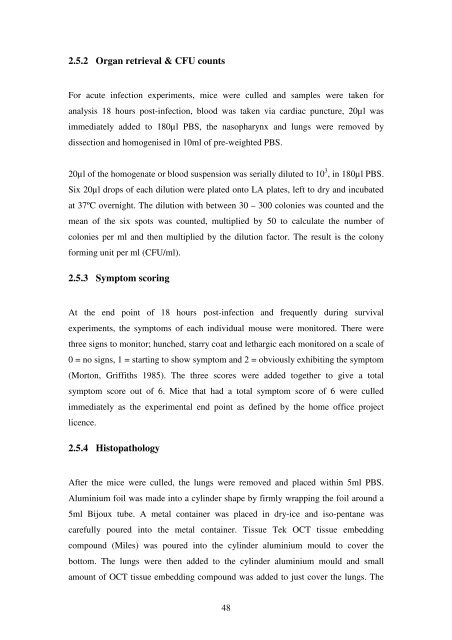5 The role of quorum-sensing in the virulence of Pseudomonas ...
5 The role of quorum-sensing in the virulence of Pseudomonas ...
5 The role of quorum-sensing in the virulence of Pseudomonas ...
You also want an ePaper? Increase the reach of your titles
YUMPU automatically turns print PDFs into web optimized ePapers that Google loves.
2.5.2 Organ retrieval & CFU counts<br />
For acute <strong>in</strong>fection experiments, mice were culled and samples were taken for<br />
analysis 18 hours post-<strong>in</strong>fection, blood was taken via cardiac puncture, 20µl was<br />
immediately added to 180µl PBS, <strong>the</strong> nasopharynx and lungs were removed by<br />
dissection and homogenised <strong>in</strong> 10ml <strong>of</strong> pre-weighted PBS.<br />
20µl <strong>of</strong> <strong>the</strong> homogenate or blood suspension was serially diluted to 10 3 , <strong>in</strong> 180µl PBS.<br />
Six 20µl drops <strong>of</strong> each dilution were plated onto LA plates, left to dry and <strong>in</strong>cubated<br />
at 37ºC overnight. <strong>The</strong> dilution with between 30 – 300 colonies was counted and <strong>the</strong><br />
mean <strong>of</strong> <strong>the</strong> six spots was counted, multiplied by 50 to calculate <strong>the</strong> number <strong>of</strong><br />
colonies per ml and <strong>the</strong>n multiplied by <strong>the</strong> dilution factor. <strong>The</strong> result is <strong>the</strong> colony<br />
form<strong>in</strong>g unit per ml (CFU/ml).<br />
2.5.3 Symptom scor<strong>in</strong>g<br />
At <strong>the</strong> end po<strong>in</strong>t <strong>of</strong> 18 hours post-<strong>in</strong>fection and frequently dur<strong>in</strong>g survival<br />
experiments, <strong>the</strong> symptoms <strong>of</strong> each <strong>in</strong>dividual mouse were monitored. <strong>The</strong>re were<br />
three signs to monitor; hunched, starry coat and lethargic each monitored on a scale <strong>of</strong><br />
0 = no signs, 1 = start<strong>in</strong>g to show symptom and 2 = obviously exhibit<strong>in</strong>g <strong>the</strong> symptom<br />
(Morton, Griffiths 1985). <strong>The</strong> three scores were added toge<strong>the</strong>r to give a total<br />
symptom score out <strong>of</strong> 6. Mice that had a total symptom score <strong>of</strong> 6 were culled<br />
immediately as <strong>the</strong> experimental end po<strong>in</strong>t as def<strong>in</strong>ed by <strong>the</strong> home <strong>of</strong>fice project<br />
licence.<br />
2.5.4 Histopathology<br />
After <strong>the</strong> mice were culled, <strong>the</strong> lungs were removed and placed with<strong>in</strong> 5ml PBS.<br />
Alum<strong>in</strong>ium foil was made <strong>in</strong>to a cyl<strong>in</strong>der shape by firmly wrapp<strong>in</strong>g <strong>the</strong> foil around a<br />
5ml Bijoux tube. A metal conta<strong>in</strong>er was placed <strong>in</strong> dry-ice and iso-pentane was<br />
carefully poured <strong>in</strong>to <strong>the</strong> metal conta<strong>in</strong>er. Tissue Tek OCT tissue embedd<strong>in</strong>g<br />
compound (Miles) was poured <strong>in</strong>to <strong>the</strong> cyl<strong>in</strong>der alum<strong>in</strong>ium mould to cover <strong>the</strong><br />
bottom. <strong>The</strong> lungs were <strong>the</strong>n added to <strong>the</strong> cyl<strong>in</strong>der alum<strong>in</strong>ium mould and small<br />
amount <strong>of</strong> OCT tissue embedd<strong>in</strong>g compound was added to just cover <strong>the</strong> lungs. <strong>The</strong><br />
48














